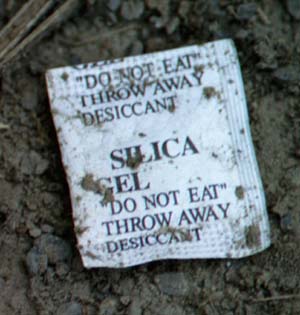
Ever the obedient consumer, the river path pedestrian took the message in the bottle seriously: DO NOT EAT. THROW AWAY.
Was he tempted, just for a second, to tear open the little packet and squeeze the forbidden substance onto his tongue ?
What's this ? Maybe I can get a buzz offa it. "Si-li-ca gel." What wuzzit I read about silica -- is that the stuff you can make speed outta ? No, wait. That's sudafed. Oh yeah. Tits. It's the stuff they shoot into tits to make 'em bigger. Better chuck it. I don't need no big tits.
Sand. Silicon dioxide.
I worked in a diode factory for six months before I began medical school. The company was called American Power Devices and it was down a winding, tree-lined road from my parents' house in northern Massachusetts. It was 1973. Silicon Valley was still a twinkle in capitalism's eye. IBM punch cards and Univac were household words emeriti.
I guess that would put me in on the ground floor of the microchip revolution.
It was a fascinating place and I had a fascinating job. There were long, tubular furnaces into which I had to slide trays of silicon wafers, thin and perfect as communion hosts, to imbue them with boron and phosphorous and turn them into semiconductors. Then there was the little plexiglass hood, bigger than a breadbox, smaller than a coffin, under which I scoured the wafers with a waterpik-like sand jet. It seemed far too delicate an operation for its name: sandblasting. The radio played Killing Me Softly over and over that summer. To this day the song reminds me of sandblasting silicon wafers -- the hiss of sand on silicon, the slowly burnishing surfaces.
There was another machine -- a bell jar the size of a juke box -- that vaporized little corkscrews of gold wire and gold plated the silicon wafers. I remember the gutteral glug glug glug of its vacuum pump. Then there was a cold, windowless room where I'd coat the wafers with a purplish gel to prepare them for etching. I don't remember the details of the process, but I remember how peaceful it was in that little room with its humming ventilators, precise little instruments and aromatic reagents. It was like a hermitage. I loved it in there. I loved performing the meticulous little chemical liturgies. Like saying mass. Sand from sand, light from light. I felt safe in there, protected from the unruly, impinging world.
Out back, across a narrow, empty meadow, freight trains passed several times a day . I'd stop and sneak a long look at them as they went by. Cows used to graze that field, and in its previous incarnation, the factory had been their barn. I'd visited it as a child after buying ice cream from the dairy stand next door. I loved the hot, shadowy, redolent barn and the placid animals, languidly swishing their tails against the fat, lazy flies. How odd to be there , fifteen years later, in an ultra-clean, chilly room anointing little wafers with purple resin. Burnishing them under a plastic hood. Blasting boron atoms into silicon. Vaporizing gold in a big bell jar.
And how odd to be revisiting these places thirty years later, led back by a bright trail of silicon crumbs. What if I'd heeded the alchemical seductions of these magnificent substances and become a chemist instead of a physician ? Listened to my deepest, most reclusive inclinations and spent three decades in the clean, lonely space of a lab (or hermitage or library or writer's garret) instead of the thronged, malodorous and messy cowbarn of the clinic ?
The smells of manure and xylene mingle, contrapuntal, in memory. Killing me softly with their song.
No comments:
Post a Comment